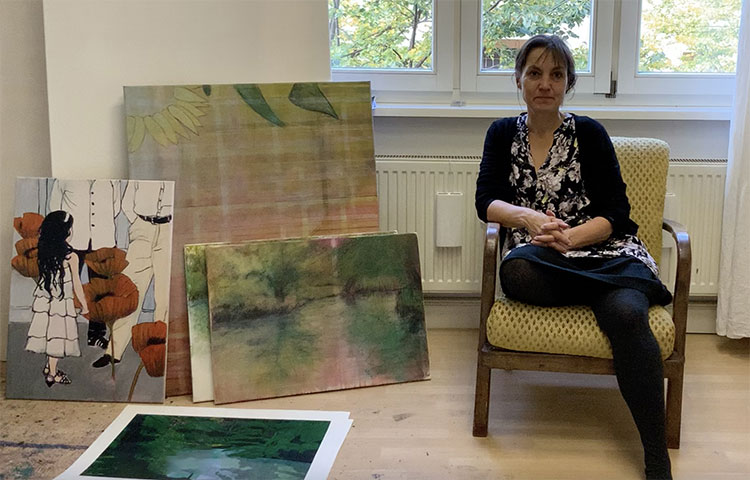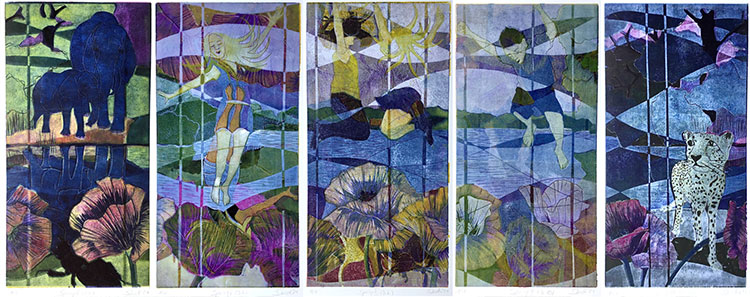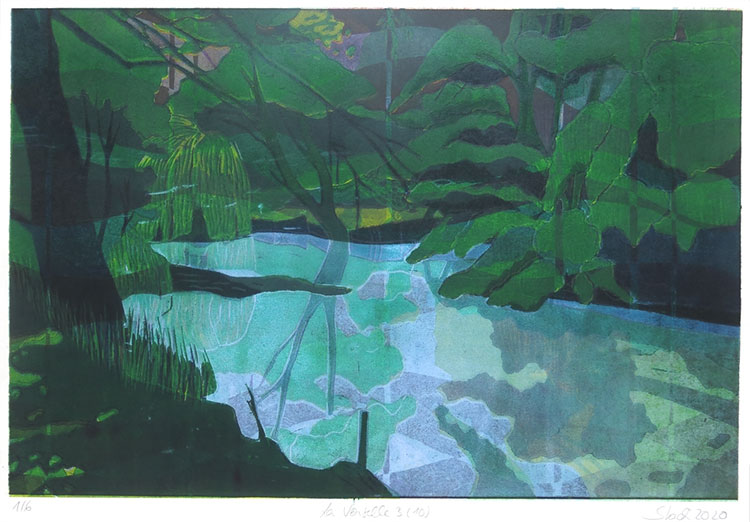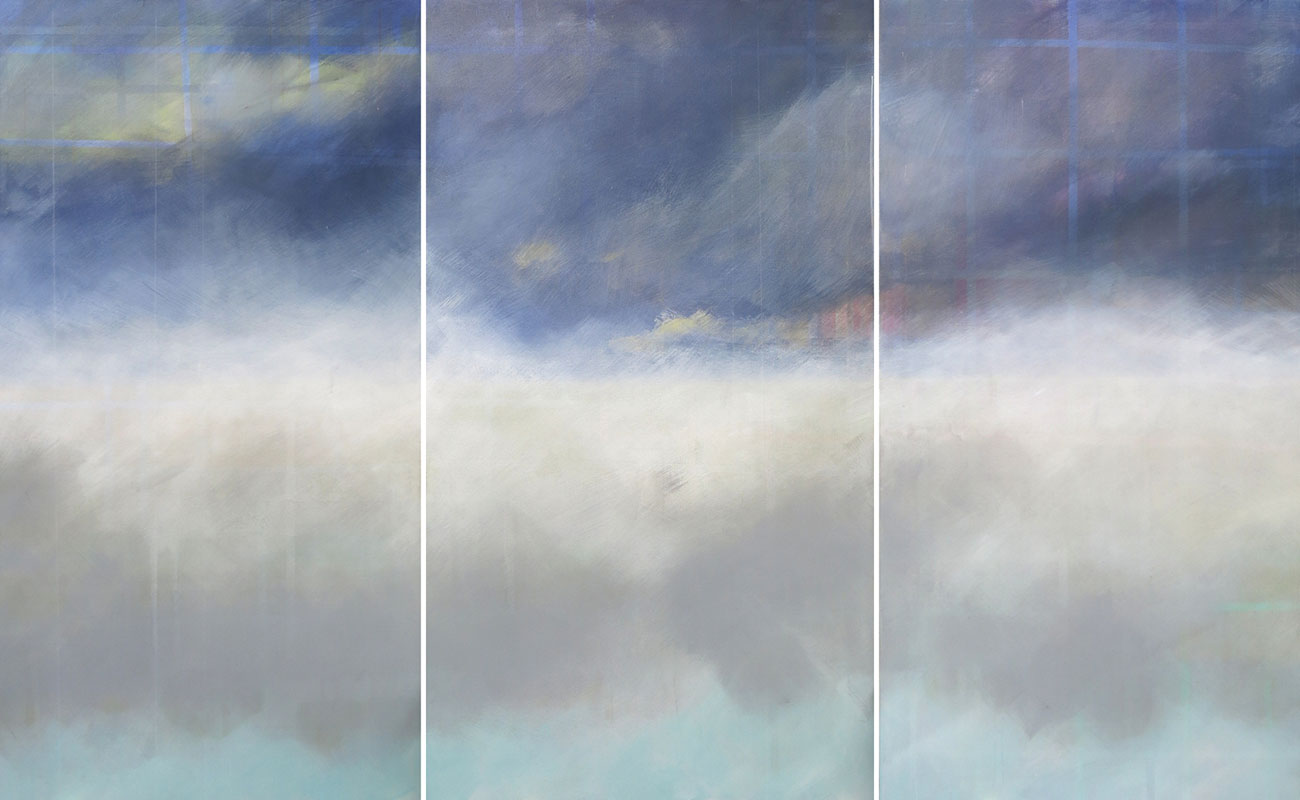“I see landscape as a filter for what lies beneath, allowing underlying realities and truths to subtly emerge, encrypted and only partially disclosed. Rather than endeavoring to decipher what lies below or beyond, my aim is to preserve the secret and maintain the beauty that may reside precisely in the enigmatic density and encryption of the world.”
A Journey Through Art: Skadi Engeln’s Evolution and Creative Process
Skadi Engeln‘s parents’ scientific backgrounds and Catholic upbringing fostered an environment filled with inquisitive discussions about fundamental questions concerning life, the universe, and humanity. This exposure to the intricate enigma of the world has been a major influence on Engeln’s artistic expression. During her studies between 1990 and 1995, she explored the expressive capacities of color and form, investigating their interplay in various combinations. Rather than unveiling hidden secrets, Engeln sought to preserve the enigma that is often associated with beauty.
Engeln’s interest in psychology led her to explore various art therapies, acquiring valuable insights into colors, forms, and materials, as well as their interactions and communicative properties. Although her artistic focus initially began with sculpture, Engeln later shifted to painting, allowing her to experiment more easily with ideas of dissolution and composition.
Engeln has exhibited her work in numerous solo and group exhibitions around the world, including Berlin, Düsseldorf, Bonn, Hamburg, Munich, Paris, Graz, New York, and Molde. She received her education at FH Ottersberg, studying sculpture under Robert van de Laar and painting with Michael Kohr and Hermanus Westendorp. She currently resides and works in both Berlin and France.
Engeln’s primary focus is creating paintings on canvas and paper, as well as prints on paper, such as woodcuts and silkscreens. Her subject matter often revolves around landscapes and figures, with a keen interest in how landscapes can reflect the world, using perception, reproduction, and reflection to create a masterful interplay in her work. Engeln finds that landscapes are constantly in a state of transition, with elements like light, water, weather, and human presence perpetually causing it to undergo decomposition. She believes that these transitions unveil the essence, transcendence, and beauty of the landscape. Engeln also sees parallels between the nature of painting and landscape, as both have the ability to dissolve the specific, solid, visible, and familiar in order to trace the invisible, without ever fully comprehending it.

Skadi Engeln’s Diverse Workspaces: Landscapes and Studios
Skadi Engeln perceives landscape as a conduit that unveils underlying realities and truths, allowing them to emerge subtly, encrypted, and only partially revealed. Rather than attempting to unravel the hidden depths or what lies beyond, Engeln’s intention is to uphold the mystery and embrace the inherent beauty that may reside within the enigmatic complexity and encryption of the world.
Engeln’s ideal working environment often involves wandering through diverse landscapes and observing the situations that unfold around her. These journeys and hikes provide her with a wealth of visual experiences that inform her creative process. The artist primarily works on her paintings in her Berlin studio, drawing inspiration from photographs captured during her travels.
For her woodcuts, Engeln operates from an outdoor summer studio, directly inspired by the landscape of Berry in central France, as well as by the photographs taken in the region. She prints her multi-layered woodcuts in a prominent printing workshop in Berlin-Kreuzberg, which serves international printers and offers her opportunities for rich exchange with fellow artists. Engeln handprints the multicolored woodblocks on a printing press, meticulously observing the evolution of each sheet as it is overprinted up to 15 times with transparent and opaque layers until completion. The printing process itself is a painterly and inventive endeavor for Engeln, resulting in numerous unique pieces.
Another essential workspace for the artist is her iPad, often situated on a sofa with a cat resting on her abdomen. In this minimalist setting, Engeln designs her screen prints, which she later prints herself. This combination of diverse working environments allows Engeln to continually draw inspiration from the world around her, resulting in an art practice that captures the enigmatic beauty of both landscapes and the human experience.

Landscapes, Laughter, and Intertwining: Inspirations and Themes in Engeln’s Art
Skadi Engeln derives inspiration from a diverse range of sources, including landscape observations, life drawings, global events, news, and conversations. She particularly appreciates the work of fellow artists such as Mark Rothko, who is renowned for his layered color techniques.
In 2001, following an extensive journey along the Camino de Santiago in Northern Spain, Engeln discovered her affinity for landscapes as a subject matter. She began to explore the deeper connection between the landscape and the world at large, embracing the concept of transcendence in her artistic practice. This newfound interest led her to imbue her previously abstract works with more tangible elements, such as a discernible horizon that separated the sky and the earth. Engeln’s art evolved to feature intricate layers and transparency, enabling viewers to appreciate the interplay between foreground and background elements.
The artist’s earlier somber and serious portraits were gradually replaced by a focus on human laughter, which she considered a unifying force among people and a subtle gateway to addressing existential questions. Concurrently, her landscape paintings shifted from abstract to representational, until a radical change occurred in 2011, following the Fukushima nuclear accident. Engeln’s work began to incorporate disturbances that represented the conflict between humanity and nature, with vertical elements like stripes, curtains, and brushstrokes symbolizing human presence and influence.
Taking inspiration from Caspar David Friedrich, who often incorporated the human figure as an observer and active participant within powerful landscapes, Engeln initially referred to her paintings as “interference pictures.” Over time, however, this term evolved into “intertwining” as she expanded her focus to include the perception and influence of humanity within the landscape and the world at large.
Engeln’s art is informed by her experiences with observation, acknowledging that the world is viewed through filters such as glass panes, screens, and pre-existing ideas or memories. Landscapes, for instance, often become intertwined with associated memories, music, or conversations. The presence of humans within these landscapes highlights the impossibility of uninfluenced, objective observation and perception.
Since 2016, Engeln has reintegrated the human figure into her work, transforming landscapes from mere objects of observation into stages for events and interactions. The incorporation of digital tools like the iPad has facilitated her playful approach to creating collage-like works and designs. As a result, her art has become increasingly associative, absurd, and surreal, a development that has extended to her landscape paintings since 2022.
Engeln’s work has also centered around children and their experience of the world since 2017. In response to the global pandemic, environmental disasters, and ongoing crises and wars, she seeks to provide them with a sense of hope and perspective through her “Jumping Children” series, which encourages viewers to look beyond the immediate horizon.

Skadi Engeln’s Foray into Printmaking and Cherished Creations
Between 2011 and 2014, Skadi Engeln divided her time between Berlin and Paris. In the French capital, she faced a significant constraint in terms of workspace, prompting her to explore printmaking. Engeln found that she could easily prepare woodblock prints on her modest kitchen table and print them at a community print studio, initially in Paris. The intricate nature of her paintings had long been calling for such a medium, but it was the dynamic and diverse printmaking community in Paris that ultimately catalyzed her decision to pursue it. The artist expressed a desire for more time to immerse herself in the creative process, allowing for further development of her craft through creation, reflection, and observation.
When discussing her most cherished creations, Engeln cites “Water Reflections – La Voiselle” and “Spring I-V” as standout pieces. “Water Reflections – La Voiselle” is a 2020 series of wood prints, based on photographs captured along the Voiselle River in France. These prints were meticulously carved in Engeln’s French studio and subsequently hand-printed in Berlin. The collection consists of five individual motifs that can either be appreciated independently or arranged together, forming a captivating image of children leaping on a trampoline above a lake while wild animals observe nearby.
In contrast, the “Spring I-V” series showcases vibrant, multicolored wood prints that draw inspiration from both the COVID-19 pandemic and various environmental catastrophes. The five distinctive motifs can be assembled into a larger composition or enjoyed as unique designs in limited, small editions or as individual works.






